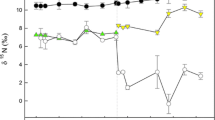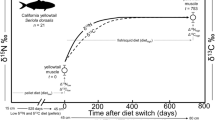Abstract
Isotope turnover in muscle of ectotherms depends primarily on growth rather than on metabolic replacement. Ectotherms, such as fish, have a discontinuous pattern of growth over the year, so the isotopic signature of muscle (δ13C and δ15N) may only reflect food consumed during periods of growth. In contrast, the liver is a regulatory tissue, with a continuous protein turnover. Therefore, the isotopic composition of liver should respond year round to changes in the isotopic signature of food sources. Therefore, we predicted that (1) Whitefish in Lake Geneva would have larger seasonal variation in the isotopic variation of the liver compared to that of the muscle tissue, and (2) the isotope composition of fish muscle would reflect a long-term image of the isotope composition of the food consumed only throughout the growth period. To test these expectations, we compared the isotope compositions of Whitefish muscle, liver and food in a 20-month study. We found that the seasonal amplitude of isotope variation was two to three times higher in liver compared to muscle tissue. During the autumn and winter, when growth was limited, only the isotopic signature of liver responded to changes in the isotope composition of the food sources. The δ13C and δ15N of muscle tissue only reflected the food consumed during the spring and summer growth period.




Similar content being viewed by others
References
Adams TS, Sterner RW (2000) The effects of dietary nitrogen content on the trophic level δ15N enrichment. Limnol Oceanogr 45:601–607
Bruslé J, Quignard J-P (2001) Biologie des poissons d’eaux douces européens. Technique et Documentation, Londres Paris
Caranhac F (1999) Modélisation de la dynamique de populations piscicoles exploitées intégrant la variabilité annuelle de croissance : applications aux corégones (Coregonus lavaretus) du lac d’Annecy. Thesis Claude Bernard University, Lyon, p 276
Conover WJ (1980) Practical nonparametric statistics, 2nd edn. Wiley, New York
De Niro M, Epstein S (1978) Influence of the diet on the distribution of carbon isotopes in animals. Geochim Cosmochim Acta 42:495–506
Doucett RR, Booth RK, Power G, McKinley RS (1999) Effects of the spawning migration on the nutritional status of anadromous Atlantic salmon (Salmo salar): insights from stable-isotope analysis. Can J Fish Aquat Sci 56:2172–2180
Dufour E (1999) Implications paléoenvironnementales et paléoalimentaires des abondances isotopiques en Carbone et Azote des poissons téléostéens. Thesis Pierre and Marie Curie University, Paris, p 197
Frazer TK, Ross RM, Quetin LB, Montoya JP (1997) Turnover of carbon and nitrogen during growth of larval krill, Euphausia superba Dana: a stable isotope approach. J Exp Mar Biol Ecol 212:259–275
Gannes LZ, O’Brien DM, Martinez Del Rio C (1997) Stable isotopes in animal ecology: assumptions, caveats, and a call for more laboratory experiments. Ecology 78:1271–1276
Gerdeaux D, Hamelet V (2001) Régime alimentaire des corégones et des gardons du Léman, en milieu pélagique, campagne 2000. In: CIPEL (ed) Rapports sur les études et recherches entreprises dans le bassin lémanique, Lausanne, pp 137–143
Herzka SZ, Holt GJ (2000) Changes in isotopic composition of red drum (Sciaenops ocellatus) larvae in response to dietary shifts: potential applications to settlement studies. Can J Fish Aquat Sci 57:137–147
Hesslein RH, Hallard KA, Ramlal P (1993) Replacement of sulfur, carbon and nitrogen in tissue of growing broad Whitefish (Coregonus nasus) in response to a change in diet traced by delta 34S, delta 13C and delta 15N. Can J Fish Aquat Sci 50:2071–2076
de la Higuera M, Akharbach H, Hidalgo MC, Peragon J, Lupianez JA, Garcia-Gallego M (1999) Liver and white muscle protein turnover rates in the European ell (Anguilla anguilla): effects of dietary protein quality. Aquaculture 179:203–216
Hobson KA, Bairlein F (2003) Isotopic fractionation and turnover in captive Garden Warblers (Sylvia borin): implications for delineating dietary and migratory associations in wild passerines. Can J Zool 81:1630–1635
Hobson KA, Clark RW (1992) Assessing avian diets using stable carbon and nitrogen isotopes I turnover of carbon-13. Condor 94:181–188
Hobson KA, Sirois J, Gloutney ML (2000) Tracing nutrient allocation to reproduction with stable isotopes: a preliminary investigation using colonial waterbirds of great Slave Lake. Auk 117:760–774
Hyslop EJ (1980) Stomach content analysis—a review of methods and their application. J Fish Biol 17:411–429
Insightful (2001) S-Plus 6. Insightful Corporation, Seattle, Washington
Johnson BM, Martinez PJ, Stockwell JD (2002) Tracking trophic interactions in coldwater reservoirs using naturally occurring stable isotopes. Trans Am Fish Soc 131:1–13
Kelly JF (2000) Stable isotopes of carbon and nitrogen in the study of avian and mammalian trophic ecology. Can J Zool 78:1–27
Kurle CM (2002) Stable isotope ratios of blood components from captive northern fur seals (Callorhinus ursinus) and their diet: applications for studying the foraging ecology of wild otarids. Can J Zool 80:902–908
Kurle CM, Worthy GAJ (2002) Stable nitrogen and carbon isotope ratios in multiple tissues of the northern fur seal Callorhinus ursinus: implications for dietary and migratory reconstructions. Mar Ecol-Prog Ser 236:289–300
Lorrain A, Paulet Y-M, Chauvaud L, Savoye N, Donval A, Saout C (2002) Differential δ13C and δ15N signatures among scallop tissues: implications for ecology and physiology. J Exp Mar Biol Ecol 275:47–61
Mac Avoy SE, Macko SA, Garman GC (2001) Isotopic turnover in aquatic predators: quantifying the exploitation of a migratory prey. Can J Fish Aquat Sci 58:923–932
Mc Connaughey T, Mc Roy CP (1979) Food-web structure and the fractionation of carbon isotopes in the Bering Sea. Mar Biol 53:257–262
Mc Millan DN, Houlihan DF (1989) Short-term responses of protein synthesis to re-feeding in rainbow trout. Aquaculture 79:37–46
Mookerji N, Heller C, Meng HJ, Burgi HR, Muller R (1998) Diel and seasonal patterns of food intake and prey selection by Coregonus sp. in re-oligotrophicated Lake Lucerne, Switzerland. J Fish Biol 52:443–457
O’Brien DM, Schrag DP, del Rio CM (2000) Allocation to reproduction in a hawkmoth: A quantitative analysis using stable carbon isotopes. Ecology 81:2822–2831
Olive PJW, Pinnegar JK, Polunin NVC, Richards G, Welch R (2003) Isotope trophic-step fractionation: a dynamic equilibrium model. J Anim Ecol 72:608–617
Peragon J, Barroso JB, Garcia-Salguero L, de la Higuera M, Lupianez JA (1994) Dietary protein effects on growth and fractional protein synthesis and degradation rates in liver and white fish muscle of rainbow trout (Oncorhynus mykiss). Aquaculture 124:35–46
Phillips DL, Koch PL (2002) Incorporating concentration dependence in stable isotope mixing models. Oecologia 130:114–125
Pinnegar JK, Polunin NVC (1999) Differential fractionation of δ13C and δ15N among fish tissues: implications for the study of trophic interactions. Func Ecol 13:225–231
Ponton D (1986) Croissance et alimentation de deux poissons planctonophages du lac Léman : le Corégone (Coregonus sp.) et le gardon (Rutilus rutilus). Thesis Claude Bernard University, Lyon, p 156
Roth JD, Hobson KA (2000) Stable carbon and nitrogen isotopic fractionation between diet and tissue of captive red fox: implications for dietary reconstruction. Can J Zool 78:848–852
Tieszen LL, Boutton TW, Tesdahl KG, Slade NA (1983) Fractionation and turnover of stable carbon isotopes in animal tissues: Implications for delta-13 C analysis of diet. Oecologia 57:32–37
Zohary T, Erez J, Gophen M, Berman-Frank I, Stiller M (1994) Seasonality of stable carbon isotopes within the pelagic food web of Lake Kinneret. Limnol Oceanogr 39:1030–1043
Acknowledgements
We would like to thank the participants at the “Stable Isotope Ecology Conference” and two anonymous referees whose questions and comments definitely helped improve this manuscript. We acknowledge Blake Matthews for his comments and editing corrections of the manuscript. This work was supported by the ‘ACI écologie quantitative ’program from the French Ministry of Research.
Author information
Authors and Affiliations
Corresponding author
Additional information
Communicated by Jim Ehleringer
Rights and permissions
About this article
Cite this article
Perga, M.E., Gerdeaux, D. ‘Are fish what they eat’ all year round?. Oecologia 144, 598–606 (2005). https://doi.org/10.1007/s00442-005-0069-5
Received:
Accepted:
Published:
Issue Date:
DOI: https://doi.org/10.1007/s00442-005-0069-5




